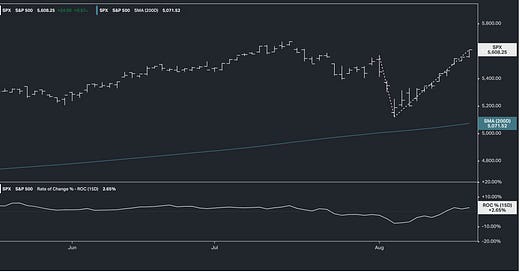Don't Call it a Cycle
US stocks maintained their upward momentum on Monday, building on the gains from the best week in a year and adding over $3 trillion in value from this month's lows.
The S&P 500 and Nasdaq gained 1% and 1.2%, respectively, extending their winning streak to eight consecutive days, while the Dow Jones added 236 points.
All sectors closed in the green, with communication services and technology leading the gains.
Among individual stocks, AMD surged 4.5% after announcing its acquisition of ZT Systems, a provider of artificial intelligence infrastructure.
Palo Alto Networks rose 2.8% ahead of its earnings report set for after the closing bell.
A crisis-like shock that took place to start the month.
It was driven by the outlook on central bank policies in Japan and the U.S. — mostly, the prospect of Japan's exit from emergency level policies which would reduce global liquidity and financial stability (which includes the reduced appeal of the yen carry trade).
In response to the market shock, at the depths of the decline the Deputy of the Bank of Japan gave a very direct, prepared speech titled Japan's Economy and Monetary Policy. In it, he went to great lengths to communicate to markets that the moves in the Japanese stock market and in the yen were unwelcome ("unstable" in his words) — and as a result he said the Bank would "maintain monetary easing" for the time being.
So, just days after taking the second step toward exiting emergency level policies, the Bank of Japan was forced to walk it back (verbal intervention, if not actual intervention/asset purchases).
As you can see in the chart below, U.S. stocks have since had a full V-shaped recovery.
With the above in mind, let's talk about the big event of this week - the Kansas City Fed will host its annual economic symposium in Jackson Hole, Wyoming, beginning Thursday and running through Saturday.
This event will be well attended by the world's most powerful central bankers and finance officials. Historically, it has served as a platform for central bankers to communicate important signals regarding policy adjustments.
With that, Jerome Powell will deliver a prepared speech at 10am (EST) Friday morning.
Clearly the potential "policy adjustment" here would be the signal to kick off the easing cycle in September. How can the Fed position it, as to not trigger another purge of the yen carry trade (i.e. selling dollars, buying back yen) – and send markets into a tailspin.
Don't call it an easing cycle.
He can follow the playbook of the European Central Bank and the Bank of Canada, by positioning a rate cut as just "reducing restriction" to maintain the level of restriction as inflation has fallen — not necessarily the beginning of an easing cycle, just reducing restriction.
He laid the groundwork for it in the post-FOMC press conference a few weeks ago, saying "the job is not done on inflation, but nonetheless we can afford to begin to dial back restriction in our policy rate."
That, plus the Bank of Japan's walk back on a tightening path might keep markets in check.
GRYNING | Signals - Where you can access six quantitative strategies to generate systematic trading signals with precise entries and exits in the weekly timeframe. The strategies cover price series and cross-sectional momentum, mean reversion, and long/short with major ETFs and large-cap stocks.
For more information, and to become a member, click on the link below - membership is limited and filled on a first come basis.








